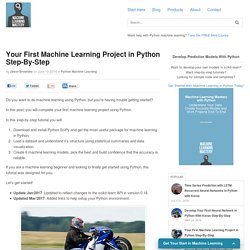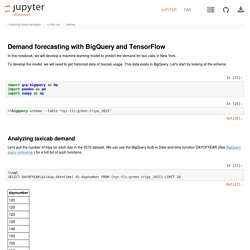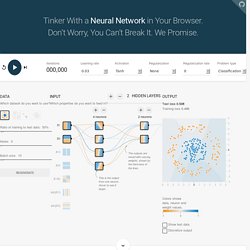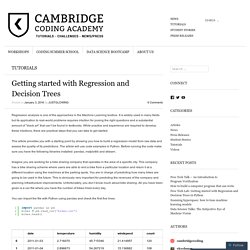

Hugorut/neural-cli: command line neural network. Pattern_classification/README.md at master · rasbt/pattern_classification. Your First Machine Learning Project in Python Step-By-Step. Do you want to do machine learning using Python, but you’re having trouble getting started?

In this post, you will complete your first machine learning project using Python. In this step-by-step tutorial you will: Download and install Python SciPy and get the most useful package for machine learning in Python.Load a dataset and understand it’s structure using statistical summaries and data visualization.Create 6 machine learning models, pick the best and build confidence that the accuracy is reliable.
If you are a machine learning beginner and looking to finally get started using Python, this tutorial was designed for you. Let’s get started! Update Jan/2017: Updated to reflect changes to the scikit-learn API in version 0.18.Updated Mar/2017: Added links to help setup your Python environment. Machine Learning is Fun! Part 4: Modern Face Recognition with Deep Learning. Face Recognition — Step by Step Let’s tackle this problem one step at a time.

For each step, we’ll learn about a different machine learning algorithm. I’m not going to explain every single algorithm completely to keep this from turning into a book, but you’ll learn the main ideas behind each one and you’ll learn how you can build your own facial recognition system in Python using OpenFace and dlib. Step 1: Finding all the Faces The first step in our pipeline is face detection. If you’ve used any camera in the last 10 years, you’ve probably seen face detection in action: Face detection is a great feature for cameras. Face detection went mainstream in the early 2000's when Paul Viola and Michael Jones invented a way to detect faces that was fast enough to run on cheap cameras.
To find faces in an image, we’ll start by making our image black and white because we don’t need color data to find faces: TensorFlow-Examples/README.md at master · aymericdamien/TensorFlow-Examples. Deep-base/README.md at master · dominiek/deep-base. Notebook Viewer. We'll use 80% of our dataset for training and 20% of the data for testing the model we have trained.

Let's shuffle the rows of the Pandas dataframe so that this division is random. The predictor (or input) columns will be every column in the database other than the number-of-trips (which is our target, or what we want to predict). The machine learning models that we will use -- linear regression and neural networks -- both require that the input variables are numeric in nature. The day of the week, however, is a categorical variable (i.e. Tuesday is not really greater than Monday). Against that, we do have limited data (remember: the more columns you use as input features, the more rows you need to have in your training dataset), and it appears that there is a clear linear trend by day of the week. A Neural Network Playground. Um, What Is a Neural Network?

It’s a technique for building a computer program that learns from data. It is based very loosely on how we think the human brain works. First, a collection of software “neurons” are created and connected together, allowing them to send messages to each other. Next, the network is asked to solve a problem, which it attempts to do over and over, each time strengthening the connections that lead to success and diminishing those that lead to failure. Machine Learning for Artists. #Google has started a new #Python #MachineLearning course on YouTube. #sklearn. Getting started with Regression and Decision Trees. Regression analysis is one of the approaches in the Machine Learning toolbox.

It is widely used in many fields but its application to real-world problems requires intuition for posing the right questions and a substantial amount of “black art” that can’t be found in textbooks. While practice and experience are required to develop these intuitions, there are practical steps that you can take to get started. This article provides you with a starting point by showing you how to build a regression model from raw data and assess the quality of its predictions.
The article will use code examples in Python. Before running the code make sure you have the following libraries installed: pandas, matplotlib and sklearn. Imagine you are working for a bike sharing company that operates in the area of a specific city. You can import the file with Python using pandas and check the first five lines: Bingo!
It is a rule based technique. Array([ 189.23183761]) array([ 769.08756039]) Want to learn more? Mlxtend.